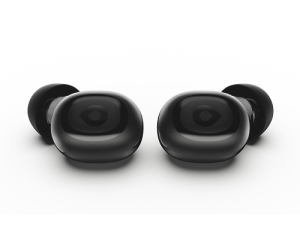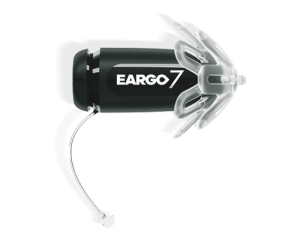- Cost per pair: $799 if paid in full or $25 per month if financed
- Dimensions: 1.04 x 0.59 x 0.81 inches (″)
- Weight: 0.169 ounces (oz)
- Type of hearing aid: In-the-ear (ITE) earbud style
- Type of hearing loss: Mild to moderate high-frequency hearing loss
- Battery type: Rechargeable
- Bluetooth compatible: Yes
Eargo Hearing Aids: Tested & Reviewed for 2025
Key Takeaways
- We recommend the Eargo 7 hearing aid as the company’s top product. It’s a discreet hearing aid that is easy to set up through the linked mobile app and gives you 16 hours of all-day use.
- The cost for Eargo hearing aids range from $799–$2,950 per pair before discounts.
- Most Eargo hearing aids include a one-year warranty; the Eargo 7 comes with a two-year warranty.
- Eargo gives you 45 days to return your hearing aids if they are not a good fit for you.
Close to 15% of American adults experience hearing loss. Hearing aids are an effective tool to treat hearing loss, but only about 20% of the people who could get help from a hearing aid actually use one. Many people wait an average of 10 years before deciding to get help for their hearing, due to factors such as cost and stigma.
Eargo offers several over-the-counter (OTC) hearing aid models ranging from $799–$2,950 per pair, all of which are designed to be nearly invisible.
Because they’re over the counter, you don’t need a prescription to buy Eargo hearing aids, and you don’t need to see an audiologist to get fitted for them. Eargo also offers an online hearing test to gauge your hearing loss. But before taking an online hearing test, experts recommend you get an in-person hearing exam at a hearing clinic to rule out any issues causing your hearing loss that can’t be addressed by hearing aids.
Because Eargo is an OTC hearing aid, all of the models reviewed here are only suited for people with mild to moderate hearing loss, as all FDA-approved OTC hearing aids are.
Learn about some of the other OTC hearing aid brands we tested in our review of the best OTC hearing aids. And see which hearing aids offer good value at a lower price in our review of the most affordable hearing aids.

If you experience a sudden loss of hearing in one or both ears, go to the nearest emergency department for immediate medical attention.
Eargo Link
Our expert take on the Eargo Link hearing aid
Eargo Link is an earbud style, ITE hearing aid offering more versatility than the Eargo SE and Eargo 7. It features Bluetooth 5.3, the latest version of Bluetooth, so you can also use it to stream music and take phone calls. Like the other Eargo models we reviewed, the Link includes noise reduction for better sound quality.
Although it’s not waterproof, the Eargo Link is sweat-resistant, making it a good option for people who want to wear their hearing aids while exercising. We also like that it’s rechargeable. The biggest problem we have with this model is the charge only lasts for nine hours. While good for limited use, it misses the mark for all-day hearing, making it a less-than-convenient option for people who need a hearing aid for longer daily use.
“If a hearing aid offers ‘all-day hearing,’ it is designed to provide continuous functionality and performance for all hours of the day on a single charge,” said Hunter Gerhart, AuD, director of audiology at Livingston Hearing Aid Center in Dallas. “This feature is important because users want to trust their hearing aids will perform at peak capacity throughout the entire day, allowing them to engage in their daily activities without needing to stop and recharge.”
The Eargo Link is similar in appearance to the types of earbuds worn for listening to music—which makes it a less discreet, more visible option than the Eargo SE and Eargo 7. For people who are self-conscious, the modern appearance of the Link may make them more likely to wear their hearing aids every day.
When we surveyed 600 hearing aid users, the biggest challenge hearing aid users had with their devices was the cost. The Eargo Link may be a more affordable option for people who are looking for a hearing aid they only need for part of the day and who aren’t concerned with around-the-clock coverage. But for people needing a hearing aid for more than nine hours at a time, or who prefer a less visible hearing device, the Link may not be a good fit.
Eargo SE
Our expert take on the Eargo SE hearing aid
The Eargo SE hearing aid is a step up from the Eargo Link. It’s smaller in size and has a removal thread that makes it easy to take out of your ear. But the biggest improvement from the Eargo Link is its battery life, allowing you to use it for almost twice as long as the Eargo Link before you need to recharge it.
You can use the Eargo app to set up your device, personalize your settings, and to switch between four preset listening programs. This is a valuable benefit, considering our survey respondents ranked ease of setup and use as the most important feature in a hearing aid (ahead of price).
The Eargo SE is sweat-resistant, so you can keep it in during workouts. A drawback with this hearing aid, though, is it’s not Bluetooth-compatible, so you can’t stream music or connect your hearing aids to an external audio source like you can with the Eargo Link. Still, what it loses in Bluetooth connectivity is made up for in its smaller, almost invisible size.
The Eargo SE costs more than the Eargo Link. But being able to wear it for nearly twice as long without a recharge may make it worth the extra cost.
If you’re looking for an invisible hearing aid, visit our review of the best invisible hearing aids.
Eargo 7
Our expert take on the Eargo 7 hearing aid
The Eargo 7 is the company’s top-of-the-line option and offers 16 hours of use with a single charge. We like its compact, CIC design and the fact it’s water-resistant. We also appreciate that it comes with an on-the-go charging case.
Although it is the most expensive Eargo model, this model offers a lot of perks. The Eargo 7 has built in Sound Match technology, which gives you the ability to customize your settings more precisely and optimize your hearing experience. You can also customize the settings through the Eargo app as needed based on your surroundings—whether in a restaurant or at home watching TV. According to our testers the setup process can be time consuming, but overall, the customization options for this hearing aid make it a solid choice.
This hearing aid is water-resistant, so you can feel confident wearing your hearing aids while exercising or getting caught in the rain. And we like that it comes with a longer warranty of two years; the Eargo Link and Eargo SE only have a one-year warranty.
Although this higher-end hearing aid doesn’t come with Bluetooth capabilities like the less expensive Eargo Link does, it’s only because its small size limits the amount of technology that can be included in the device.
We would still like to see the Eargo 7 have a longer battery life. Other OTC hearing aid brands we’ve reviewed offer longer battery life at the same price as the Eargo 7, but they’re larger and more visible, and usually have shorter warranties.
Pros and cons of Eargo hearing aids
Pros
- Available without a prescription
- Different price ranges
- Payment plans available for up to 36 months
- Eargo app for hearing aid customization
- 45-day return option
- Discreet, nearly invisible design
Cons
- Two models have only a one-year warranty
- The smaller, higher-cost options don’t have Bluetooth streaming
How to purchase
You can buy Eargo hearing aids directly from the company website. You can also get them from local retailers like Target, or from online retailers like Amazon. Since they’re OTC hearing aids, you don’t need a prescription to buy them.
The lower-cost Eargo SE and Link hearing aids come with a one-year warranty, while the Eargo 7 offers a two-year warranty.
Eargo cost
Eargo hearing aid costs range from $799–$2,950 before discounts. Features like environment settings, how long the devices last before needing a recharge, and warranties all impact the price. While they’re not the lowest cost hearing aids available, there aren’t any other OTC hearing aid brands that offer a CIC model as small as the Eargo 7 and SE.
You can save money on a new pair of Eargo hearing aids by watching for sales and discounts. Eargo also offers discounts for first responders, health care workers, and veterans (the discount can’t be combined with other promotions).
Eargo accepts health savings account (HSA) and flexible spending account (FSA)ⓘ Accounts that allow you to set aside money on a pretax basis for qualified medical expenses cards toward the cost of hearing aids. Although health insurance doesn’t typically cover OTC hearing aids, you may be able to use insurance for your Eargo devices if your health insurance company offers supplemental hearing benefits administered through NationsBenefits.
Eargo contact and payment information
Eargo customer service
You can reach Eargo customer service by:
- Phone: 855-212-2908, available Monday through Friday from 8 a.m. to 8 p.m. CT, and Saturday from 8 a.m. to 5 p.m. CT
- Live chat: Via the website from 9 a.m. to 5 p.m. CT
Payment options
Eargo accepts Visa, MasterCard, American Express, and Discover. You can also use Bread to finance your purchase for up to 36 months.
Health care workers and first responders are eligible for a 10% discount. Veterans and active military service members are eligible for a 20% discount on Eargo 7, and a 10% discount on Eargo Link and Eargo SE models. Discounts cannot be combined with other promotional codes. Call 866-988-0333 to request your discount before purchase.
Table 1, Compare Eargo hearing aids as of 2025
| Cost per pair | $799 | $1,650 | $2,950 |
| Type of hearing aid | In-the-ear earbud style | Completely-in-canal | Completely-in-canal |
| Type of hearing loss | Mild to moderate | Mild to moderate | Mild to moderate |
| Battery type | Rechargeable | Rechargeable | Rechargeable |
| Battery life (after full charge) | 9 hours | 16 hours | 16 hours |
| Bluetooth | Yes | No | No |
| Warranty (years) | 1 | 1 | 2 |
Bottom line
Although we love extras like Bluetooth connectivity for listening to music or taking phone calls, the main purpose of a hearing aid is to help with hearing. According to our surveys of hearing aid users, most people want a device that lasts throughout the day, offers several listening settings, and is easy to use. The Eargo 7 comes closest. Out of the three Eargo models reviewed here, the Eargo 7 is our top pick.
While it does come with a higher price tag and doesn’t quite offer all-day hearing, the Eargo 7 offers a good user experience and includes the security of a two-year warranty. The Eargo Link lasts just over half that amount of time before it needs a recharge. Plus, the Eargo Link and the Eargo SE only come with a one-year warranty.
For more reviews of some of the best hearing aids our team has tested, take a look at our picks for the 10 best hearing aids.
Frequently asked questions
Some Medicare Advantage plans may offer extra benefits that Original Medicare (Parts A and B) don’t cover, including certain hearing services. But Medicare doesn’t generally cover hearing aids or OTC hearing aids like the ones sold by Eargo.
Eargo is a hearing aid manufacturer.
“The main difference between a hearing aid and a hearing amplifier is the technology and intended use.” Gerhart, the audiologist, explained. “Hearing aids are regulated by the Food and Drug Administration and are used to amplify, process, and enhance sounds according to the user’s unique hearing needs. Hearing amplifiers, also called personal sound amplification products (PSAPs), are non-medical devices that are not intended to treat hearing loss. PSAPs enhance sound and are used in specific environments, such as outdoors and in lecture halls, to amplify distant sounds.”
Eargo hearing aids can be purchased over the counter without a prescription.
Questions? Email us at reviewsteam@ncoa.org.
Sources
- Johns Hopkins University. The Hidden Risks of Hearing Loss. Found on the internet at https://www.hopkinsmedicine.org/health/wellness-and-prevention/the-hidden-risks-of-hearing-loss
- Blustein J, Weinstein BE. Opening the Market for Lower Cost Hearing Aids: Regulatory Change Can Improve the Health of Older Americans. American Journal of Public Health. May 6, 2016. Found on the internet at https://ajph.aphapublications.org/doi/full/10.2105/AJPH.2016.303176
- NCOA Hearing Aids Survey. 600 respondents. Conducted using Pollfish. Launched February 2022
- Centers for Medicare and Medicaid Services. Hearing aids. Found on the internet at https://www.medicare.gov/coverage/hearing-aids



